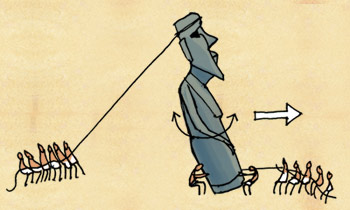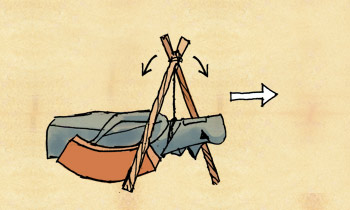A: Study how to approach diagram and table completion tasks
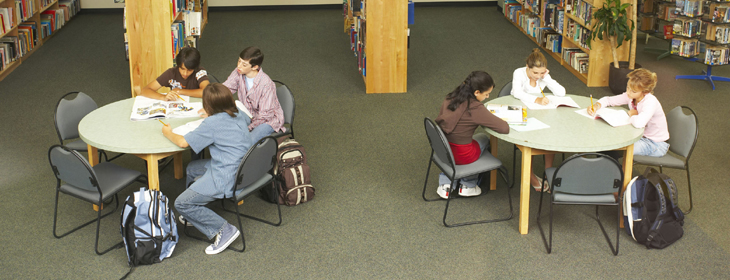
In this group of exercises you will practise table and diagram completion tasks.
1. Look at the example task.
Look at the table. Complete the missing information using words from the text. Use NO MORE THAN THREE WORDS for each question.
| Background information | Dreaming takes place during (1) _______, in periods lasting up to (2) _______ each, for a total of an hour and a half. |
| Freud and Jung | Both agreed that dreams are (3) _______. Freud said dreams could be explained on (4) _______. Jung said dreams enable us to get in touch with the (5) _______. |
| Dreams and the body | Biologists like Maurice argue that dreaming can be explained in a (6) _______ way than psychologists have suggested. Others argue that dreams enable us to (7) _______ with our physical condition. |
This type of question is similar to the sentence completion task you looked at in Unit 2B. (You might find it useful to look at that part of the course again.)
Here are the steps you need to go through in order to answer
this type of question. But they are not in the correct order. Drag
the letters A-D below the steps into the correct order.
A Now look at the notes in column 2. This will help you to focus on the specific parts of each paragraph, which you will need to look at in more detail. B Read the question carefully. Start with the headings in column 1. They tell you which paragraphs of the text you will need to look at. Remember that with this type of question you will not have to read the complete text. C Finally, look for the specific words or phrases you need to answer the questions. Remember that the answer needs to fit both grammatically and in terms of meaning. Look again at Unit 2B. D The notes in column 2 express information included in the text, but usually it is written in a slightly different way. Now look at the text and try to locate the specific parts of each paragraph that the notes are based on. Remember, too, that the notes can also be a summary of part of the paragraph. |
| The correct order is: |
2. Using the information in the question.
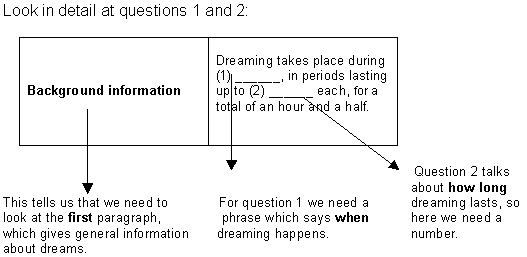
Now look at the first paragraph of the text and answer questions 1 and 2.
| Background information |
3. Practice.
Now complete the rest of the question in the same way. See the complete text again. Remember, use NO MORE THAN THREE WORDS for each question.
B: Locating information in a text

In this group of exercises you will focus on locating information in a text to complete different task types.
TIP:
It's important to read the question carefully. This will tell you what to look for in the reading text. Find the key words in the diagram or table headings and the questions. Then quickly read the text to locate and mark which paragraphs contain the information you are looking for.
1. Reading the question and locating information.
In the following exercises you will practice the task type of labelling a diagram.
TIP:
It's important to look at each gap in the question to see what kind of word you are looking for, for example, an adjective, noun or verb. Remember to read the instructions carefully to see how many words you must write. It could be one, two or three words. The words that you need to write will be exactly the same as they are in the text.
Look at different question examples and then the reading text, then answer the questions below them.
Question 1: Label the diagram below.
Choose NO MORE THAN ONE WORD from the passage for each answer.
Pavel's theory on moving the statues |
a) Pavel made a .... of the statues |
b) The method would only be possible on flat ... |
c) The crew ... the statue back |
Question 2: Label the diagram below.
Choose NO MORE THAN ONE WORD from the passage for each answer.
William Mulloy's theory on moving the statues |
d) The statue is put on a ........ |
e) It is supported by long .... poles |
f) It is moved by .... it forwards while moving the legs. |
2. Labelling a diagram.
Now answer the two sample questions you looked at in the previous exercise. Remember that in the actual exam each question task type will be different, you will not have to answer two question tasks that are the same type.
Now read the text and type your answers.
Question 1: Label the diagram below.
Choose NO MORE THAN ONE WORD from the passage for each answer.
Question 2: Label the diagram below.
Choose NO MORE THAN ONE WORD from the passage for each answer.
3. Locating information.
Now you will practise a table completion task type. Look at the table headings and say which paragraphs contain this information. For this practice activity you will use the same reading text as the previous exercises.
4. Table completion.
Now answer the sample question, completing the table you looked at in the previous exercise. Read the text here. Remember to check the number of words you must write.
Complete the table below.
Choose NO MORE THAN THREE WORDS from the passage for each answer.
C: Focus on how to deal with unknown or difficult vocabulary

In this group of exercises you will focus on dealing with unknown or difficult vocabulary.
TIP:
It is unlikely that you will understand every word in the texts you are required to read in the reading test. When dealing with unknown or difficult vocabulary it's important to consider the following points: it isn't necessary to understand every word, it's important not to stop reading when you come across an unknown word, and finally, try to use your own knowledge of the world and of English grammar to predict the meaning of unknown words. You will read more about this in exercise 2.
1. Reading comprehension.
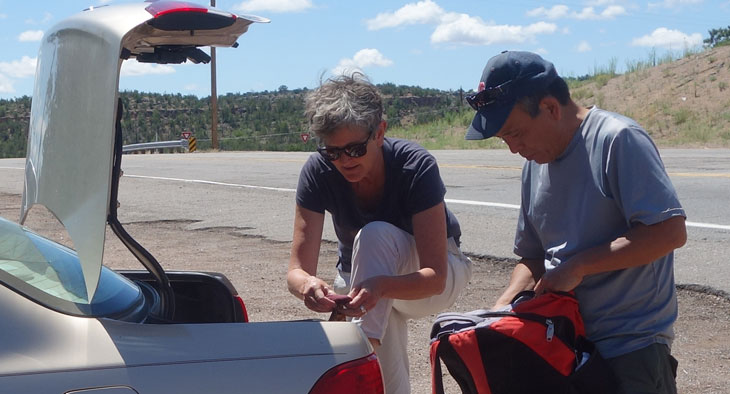
Read the text. Choose the appropriate letter A-D to complete the statements.
Hakuna Matata |
|
| 1. | We said goodbye to our friends in Nantes and headed down the west coast.
It was meant to be a quiet holiday in the pine forests south of Bordeaux,
with the bonus of long golden beaches nearby. If we had known what was in
store for us down south, we would have accepted our friends' invitation
to spend the week with them. |
| 2. | When we arrived at the cottage, the blue skies of the north had changed
to cloud and drizzle. It rained all night, and continued the next day, so
the day after we decided to visit a town further down the coast. But when
we pulled into the seafront car park, the car broke down. The man from the
Green Flag breakdown service, with trailer, responded to our phone call
after two hours. We didn't need the trailer but did need a new battery,
which, fortunately, he had. We then had to follow him to his garage, an
hour away, to pay by credit card. |
| 3. | The following day the skies cleared and we visited the beach, returning
after an enjoyable two hours to find the car had been broken into, the video
camera stolen and the windscreen smashed. It was going to take two days
and cost at least £200 to get it fixed. As our ferry was in three
days, we decided to hire a car. That was when we discovered the credit card
had been left at the garage where we bought the battery. |
| 4. | In the morning, in the rain, we cycled 12 miles to the next village to
collect the hire car. We then drove two hours to the first garage to collect
the credit card, then back to the cottage to take the washing in out of
the rain. A car pulled up, its passengers suspiciously eyeing our cottage.
It turned out to be the next occupants, who had arrived a day earlier than
expected. We didn't feel we could send them to a hotel, so we re-arranged
the cottage to accommodate an extra couple and two (separate) elderly parents. |
| 5. | Finally, having taken the hire car back and collected our own, we left, driving for seven hours in scorching heat to our friends' in the north, where the weather had been glorious for the whole week. During all that time our daughter would let us play only two cassettes, one of which was The Lion King soundtrack. From it we learned the very valuable philosophy of "Hakuna Matata" – that is, "no worries", or "when bad things happen there is nothing you can do about it!" |
2. Advice for dealing with unknown or difficult vocabulary.
It is unlikely that you will understand every word in each of the three texts you are required to read in the reading test. When dealing with unknown or difficult vocabulary in reading texts it's important to consider the following points:
| 1. |
It isn't necessary to understand every word. Many tasks – such as the previous exercise – don't require you to understand every word in the text. Also, as we have seen already in Unit 2 (as well as in this unit so far), many tasks involve looking at specific parts of a text. This means that there may be difficult vocabulary in other sentences or paragraphs that you do not need to understand. |
| 2. |
Don't stop reading when you find a difficult word. When foreign language learners see an unknown word it is natural to stop reading and try to work out the meaning of the word. However, it is often easier to understand the word if you continue reading because the rest of the sentence or paragraph may contain information which helps you to work out the meaning of the word. For example: It was meant to be a quiet holiday in the pine forests south of Bordeaux, with the bonus... In this sentence, let's assume that the word bonus is unknown. In the first part of the sentence the writer talks about having a 'quiet holiday in the pine forests'. But if we continue reading, she says: ...of long golden beaches nearby. So the second part of the sentence tells you about something extra or
an additional attraction. This helps you to make sense of the word bonus. |
| 3. |
Use your knowledge of the world. If you have a general understanding of a text, you can often work out the meaning of new vocabulary by using your knowledge of the world. For example, sentence 4 of paragraph 2 says: The man from the Green Flag breakdown service, with trailer, responded to our phone call after two hours. In paragraph 2, the writer mentions that their car has broken down and
that they have contacted a breakdown service. So the word trailer
refers to something that the breakdown service mechanic would bring with
him. When your car breaks down it is sometimes necessary to transport
it to a garage. A trailer is something
that is attached to a vehicle in order to transport something else, like
a car. |
| 4. |
Use your knowledge of grammar. Often, the same word can be used in different ways. For example: The adjective clear is used as a verb in paragraph 3:
And in paragraph 4, the noun eye is also used as a verb:
It is very common to use prefixes and suffixes to make new words in English. New vocabulary can often be worked out by thinking about the grammar of the word. For example, the following words appear:
These words have been formed by taking the words gold and enjoy and adding a suffix to create a new word. |
3. Practice.
Look at the "Hakuna Matata" text again. Find words or phrases that match the following definitions or descriptions. Type the words in the boxes.
